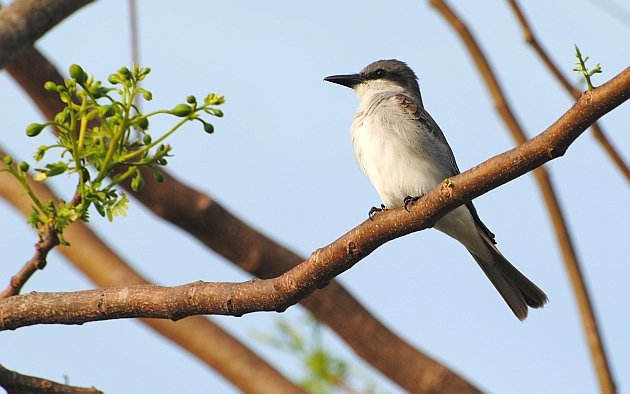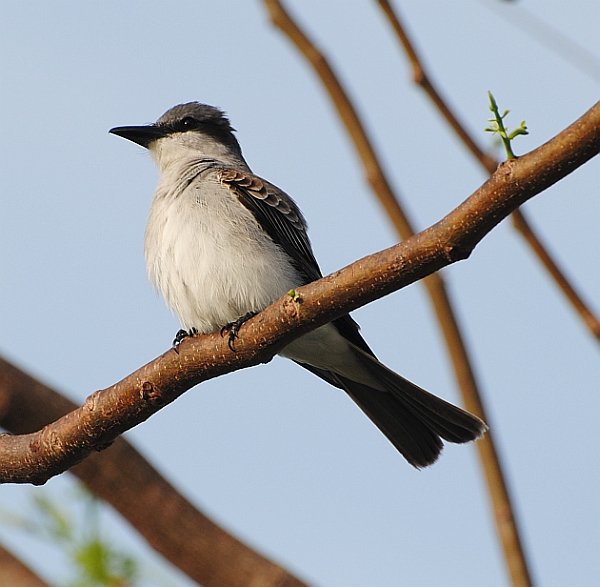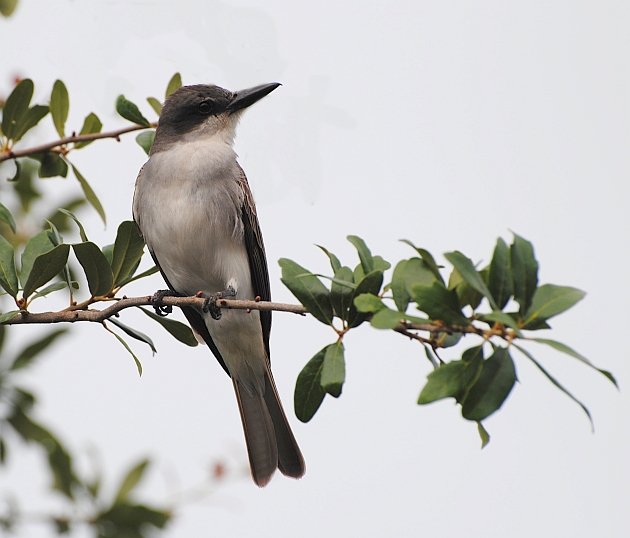
Parking lots in Miami-Dade county offer a mostly standard assortment of birds compared to the rest of the United States. We have House Sparrow, Rock Pigeon, and European Starling like almost everyone else along with the usual Ring-billed Gulls that join them in winter. Sure, we also have Common Myna and Boat-tailed Grackle which would be pretty special to most who do not live in Florida. However, my favorite parking lot bird by far is the Gray Kingbird, a tyrant flycatcher with a feisty disposition and lots of character. Every year, I look forward to their arrival in early April when they populate every parking lot in Miami from Key Biscayne to Krome Avenue. Although I have seen them utilize other more natural habitats such as mangroves and coastal scrub, Gray Kingbirds seem to have really benefited with the rampant development occurring in Miami, expanding further and further inland with each new strip mall.
Gray Kingbird perched on a Gumbo Limbo Tree, another typical West Indian species native to South Florida.
Gray Kingbird is a stocky, large-headed tyrant flycatcher with a primarily Caribbean center of distribution. Although a reasonably common species in southern Florida, Gray Kingbird is especially abundant in the West Indies where even islanders not interested in birds are very familiar with this species. Populations in the eastern part of its range, including the Dominican Republic, Puerto Rico, and the Lesser Antilles are resident while those in the western part of its range such as Florida, Cuba, Jamaica, and the Bahamas are migratory. Its wintering range includes most of northern South America.
From personal observations, Gray Kingbirds begin to migrate through southern Florida during the last few days of March and into April. However, they do not settle down and setup breeding territories at my local inland locations until the latter half of April. Like many tyrant flycatchers, they have a distinct dawn song. Nests are a crude bundle of twigs often set the middle of a small tree, including isolated ones in the middle of otherwise barren parking lots. I usually find these nests in May. It seems that every year during a brief two-week period in June or July, Gray Kingbirds fall silent and become inconspicuous only to show up again in August with a small flock of noisy juveniles in tow. By the way, the stories regarding their aggressive behavior is well founded. They even fearlessly pursue bird-eating Accipiters such as Cooper’s Hawk, pulling mouthfuls of feathers with impunity. You can almost feel sorry for the hawk. Almost.
A Gray Kingbird perched in a small live oak in the middle of a suburban parking lot in Miami.
Unfortunately, Gray Kingbirds will not be staying in Miami for much longer this year. By the end of September, the territorial birds that breed in the local parking lots are gone. By the end of October, reports of lingering migrant kingbirds dry up. I am so grateful we have these great birds to liven up the steamy summer doldrums, though! They are my preferred birding symbol of spring and summer in southern Florida. Until next year.















Great write-up and photos, especially that last one. There should be a “Great Florida Birding Trail” sign just outside the Versailles parking lot, don’t you think, Carlos?
I saw my life Gray Kingbird in the parking lot of a strip mall on Rte 1, in Dania Beach. I did have to get out of my car to make sure, since it was high on top of a light fixture. The Common Myna was much easier, Starbucks parking lot, Homestead, while waiting for the light to change at the intersection. Love Florida parking lots.
What a cool parking lot bird! I am still hoping to get a vagrant one for my Costa Rica list.
My lifer was a real anomaly – it was in Florida but in January and it must have been at least 100 yards from the nearest parking lot.
Don’t forget to mention the opportunistic gray kingbirds that use street lights for nighttime foraging. I first noted this in Miami in the 1990s. The last two years, a all- nighter pair has occupied a Papa John’s on the corner of Coral Way and SW 22nd ave, in my neighborhood. I wonder when they sleep?
we observed one hunting at night from an el. wire next to a street light on Guadeloupe. how cool!